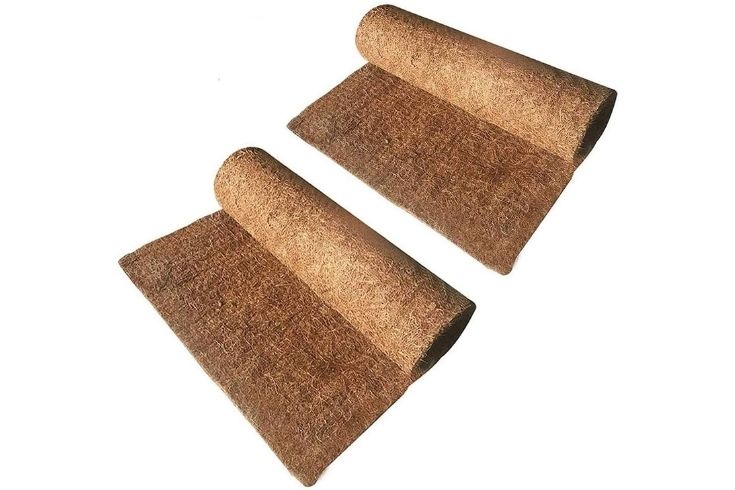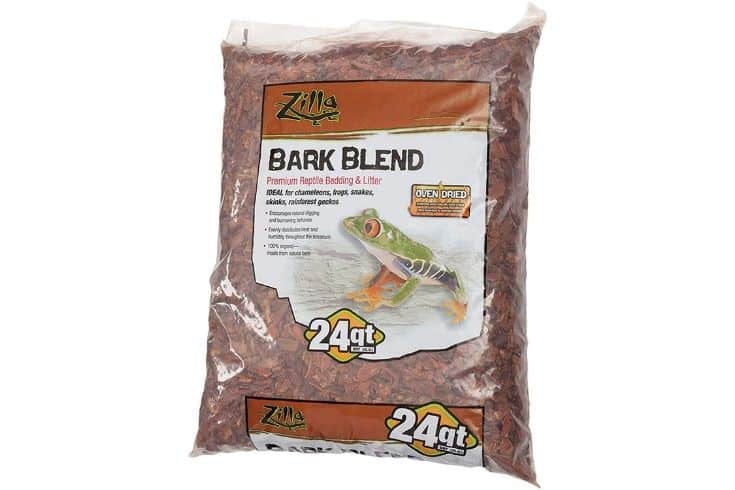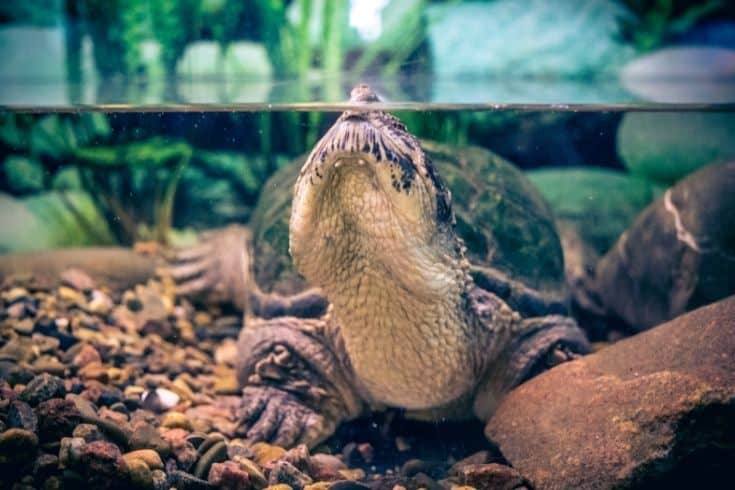Box turtles are some of the most fascinating creatures you can keep as pets, and they are fairly easy to care for if they are given what they need. As with any type of pet, the quality of your turtle’s habitat is key to its well being. A proper habitat is one that not only allows your turtle to live a long and healthy life, but also provides them with a place where they can feel safe and secure. This is where box turtle bedding comes into play.
Proper bedding is important because it provides your turtle with a soft, comfortable home where they can feel safe. The combination of the right type of bedding and the proper habitat will allow every species of box turtle to thrive both inside and outside of its tank.
Comparison Table of The 5 Best Bedding For Box Turtles

BRAND
Zoo Med Forest Floor Bedding
DETAILS
- Made of cypress mulch
- Not heat-treated
- Relatively cost-effective

Zoo Med Eco Earth Loose Coconut Fiber Reptile Substrate
- Made of coconut husk fiber
- Comes in brick and lose form
- Requires regular misting due to low water absorbency

Hamiledyi Coconut Fiber Reptile Mat
- Made of coconut fiber
- Comes in mat form
- Can be cut to size

Zoo Med Premium Repti Bark Natural Fir Reptile Bedding
- Made of fir bark
- Comes in smaller sizes, making it easier to keep clean and debris-free
- Can be reused by soaking in hot water

Zilla Bark Blend Reptile Bedding & Litter
- Made of American douglas fir
- Oven-dried to kill pests
- Loose and light to encourage burrowing
Why You Should Use Box Turtle Bedding?
Box turtles are native to the American continent and prefer forests with cool air. For this reason, the majority of box turtles are found in either dry or moist forests that have plenty of leaves to hide under. The forests they live in are not only filled with trees and grasses, but also a variety of bugs for them to eat.
One thing all species of box turtle have in common is that they are not fond of being exposed. They prefer to have things around them where they can feel safer, including soft bedding under their food dish and water bowl. This also helps them to stay cool when it’s hot outside, as all box turtles are able to dig into the ground for shelter if need be.
When choosing box turtle bedding, you should make sure that it is soft enough for your box turtle to burrow in. It should also be easy for you to clean, as turtles are known to defecate in their bedding from time to time. This will allow you to keep your pet’s habitat clean and sanitary when necessary.
What To Look For When Selecting Bedding
Now that we have discussed the importance of box turtle bedding, it is time to talk about what you should look for when selecting it. Here are some key things to keep in mind when choosing the proper bedding for your turtle.
Material
You should look for box turtle bedding that is made of a soft, organic material that will not irritate or damage your pet’s skin in any way. Many materials are good for burrowing but can cause irritating skin and respiratory issues. For instance, walnut shells, pine bark, and cat litter will wreak havoc on the digestive system of your pet turtle if they are accidentally ingested, and can also lead to respiratory issues in certain turtles.
On the other hand, orchid bark, fir bark, and sphagnum moss all make great options as base box turtle bedding for most turtle species. You can also use a combination of substrate for burrowing and soft, organic material for the base. As a box turtle owner, it is your job to know what materials are safe for your pet and which ones will cause them harm.
Physical Health Conditions

The types of beddings for box turtles you use will depend on your pet’s age, species, and health. For instance, some box turtles are prone to dry skin, so you should choose moist bedding that will keep your pet box turtle’s skin hydrated. Another major concern for box turtles is temperature fluctuations, so make sure to keep its bedding warm and pick proper bedding that makes it easy for you to do so.
Furthermore, if your turtle has any physical conditions, such as shell rot or eye infections, it is important to choose the right type of bedding accordingly. One of the biggest mistakes box turtle owners make is not taking their pet’s health into consideration, so make sure you do your research so you can pick a substrate for box turtles that will be safe for your pet.
Enclosure
Every aspect of your box turtle habitat will impact your decision. Enclosure sizes, enclosure humidity, heating elements, and additional elements such as an indoor box turtle habitat or clumpy soil will all factor into the type of bedding you select and how much substrate you need.
For instance, if your tank setup contains gravel flooring, you will need a substrate for box turtles that is deep enough to accommodate burying, whereas this is less of a priority if your turtle lives in regular sand or loose soil. In situations where insufficient humidity levels are a concern, you will need to create a box turtle environment that supports humidity retention as most species favor a humid environment. This is especially the case if yours is an indoor turtle, as air conditioners tend to remove moisture from the air.
Most importantly, you need to make sure your turtle’s enclosure has adequate space after you have introduced its bedding. This is vital if you want to have a healthy turtle and keep mental health complications at bay. The safest bet is to give your pet plenty of space so you can choose from a larger variety of box turtle bedding. The minimum aquarium size that meets this requirement is 10 gallons, but it is recommended that you go for something larger if at all possible.
Turtle Species and Life Stage
As we stated earlier, different turtles have very unique and specific needs that will all affect your choices for turtle habitats. For instance, Eastern Box Turtles (also known as the common box turtle) require a high humidity level, so a combination of coconut fiber (or fibrous coconut coir) and green Sphagnum will make an indoor box turtle enclosure a comfortable living space that closely approximates your pet’s natural habitat.
The life stage of your turtle will also impact the way you furnish your favorite box turtle tank. For instance, pregnant female turtles require an external heat source in their egg-laying stage, so you will want to make sure you provide your pet with heat lamps as indirect heat sources and substrates such as coconut fiber bedding that will trap this heat and serve as alternate heat sources.
Furthermore, hatchling and juvenile turtles are more likely to ingest any substrate they come in contact with, so you will want to make sure their habitats are mostly composed of organic bedding materials. Steer clear of bark nuggets and cedarwood chips as they may pose a choking hazard and can make your tank feel cramped – especially if you’re just meeting the minimum size requirement for your pet’s habitat.
5 Best Box Turtle Bedding – Reviews and Comparisons
Having gone through a list of factors and species-specific needs, we can now move on to our list of the five best bedding for box turtles. Since there are so many options out there, we decided to save you some time and provide you with a comprehensive list of substrates that make an excellent turtle enclosure.
1. Zoo Med Forest Floor Natural Cypress Mulch Reptile Bedding

- Made of cypress mulch
- Not heat-treated
- Relatively cost-effective
Under most circumstances, the idea of leaf mulch placed upon moist dirt sounds incredibly unappealing. As a base box turtle substrate, however, Zoo Med Forest Floor Natural Cypress Mulch Reptile Bedding is a great pick. This leaf litter product makes an excellent choice for box turtles as cypress mulch can be placed on top of regular soil or compressed soil, both of which create a stable foundation for this material.
In addition to creating a more natural enclosure with deep organic mulch, Zoo Med Forest Floor Natural Cypress Mulch Reptile Bedding is not heat-treated, which allows the mulch to absorb and retain moisture over time. This is great news as most adult turtles require a humid enclosure. Plus, the fact that this species-appropriate bedding comes in big bags means that there’s plenty of bedding to go around even if you decided to get an additional turtle.
Though cypress mulch makes great moisture-retaining bedding, you will still need to provide your pet with access to water as box turtles require some moisture to stay healthy. Not only do they need moist substrate for burrowing, they will also need clean water in their water bowls, as well as a body of water for them to take a dip in. Remember to make sure to keep its dipping pool well-filtered!
PROS
- An ideal turtle tank substrate that retains moisture and stays moist for a long time.
- The fact that it comes in big bags means you can save money as well as time by not having to worry about making regular trips to the pet store.
CONS
- Because the mulch isn’t heat-treated, bugs and wood mites may infest the substrate.
2. Zoo Med Eco Earth Loose Coconut Fiber Reptile Substrate

- Made of coconut husk fiber
- Comes in brick and lose form
- Requires regular misting due to low water absorbency
The next entry on our list is Zoo Med’s Eco Earth Loose Coconut Fiber Reptile Substrate, which is made of coconut husk fiber and makes for excellent box turtle bedding material. This product comes in both brick form and loose form. Compressed bricks are more appropriate for storage purposes, but you’ll need some elbow grease to turn a compact brick into loose bedding material. For that reason, we recommend either getting the loose fiber substrate if space is not a concern.
One of the best things about all-natural coconut fibers is that it’s perfectly suited for the unique behaviors of box turtles. For example, since this substrate is so easy to dig in, your pets can use this substrate to burrow in when they feel threatened. Unlike aquatic turtles, box turtles are not well adapted for swimming. Therefore, the ability to bury themselves in the substrate is essential for their overall well-being.
In addition, coconut fiber bedding can control humidity levels in your pet’s enclosure with regular misting. This makes it a great substrate for maintaining a proper humidity level in your tank. Though coconut husk isn’t the best at absorbing moisture, it is still rather weighty when it is freshly misted. Therefore, it is best to avoid using it on surfaces that are incapable of supporting the weight of wet coconut fiber.
PROS
- An excellent substrate for box turtles that can be used as a natural habitat.
- Coconut fiber helps maintain the best overall humidity level in your pet’s tank.
CONS
- Getting this product to its original form (for example, from compressed bricks) may take some work.
3. Hamiledyi Coconut Fiber Reptile Mat

- Made of coconut fiber
- Comes in mat form
- Can be cut to size
Much like the previous entry on our list, the Hamiledyi Coconut Fiber Reptile Mat is a sturdy product made of coconut fiber substrates that’s perfect for box turtles. However, this product has some pretty significant differences that set it apart from Zoo Med’s Eco Earth Loose Coconut Fiber Reptile Substrate.
For one, instead of being packaged as a loose substrate or compressed into a block, the Hamiledyi comes in mat form, making it super convenient for reptile hobbyists who want to get the best of both worlds. The mat is easy to lay down on any surface, and it’s equally as easy to clean up with cold or slightly warm water after your pet burrows through the substrate.
Because this reptile carpet is so portable, this is one of very few excellent substrate options for use in both indoor homes and an outdoor enclosure. Considering how versatile this product is, you can save a lot of money on bedding by getting this mat and using it in a variety of different setups. This makes it a highly budget-friendly option for hobbyists who want to do as much as they can with their purchases.
PROS
- Can be cut into any shape or size in order to fit any enclosure scenario.
- An all-natural substrate that is easy to clean with only cold or slightly warm water.
- Can be used both indoors and outdoors, saving you money on bedding material.
CONS
- Difficult to remove stains or more stubborn messes in the mat itself.
4. Zoo Med Premium Repti Bark Natural For Reptile Bedding

- Made of fir bark
- Comes in smaller sizes, making it easier to keep clean and debris-free
- Can be reused by soaking in hot water
No list of substrates for box turtle bedding is complete without Zoo Med’s Premium Repti Bark Natural For Reptile Bedding. This is one of the most aesthetically-pleasing options on our list because it is made from the bark of fir trees which lends it a natural appearance. Fir bark is also hypoallergenic, which makes it a great option for reptiles who have sensitive respiratory systems.
In addition to being environmentally friendly and hypoallergenic, Zoo Med’s Repti Bark Natural Fir is also perfectly sized to prevent crickets and other bugs from hiding in your box turtle’s bedding. Because it is cut into smaller pieces, it is super easy for you to remove any contaminants or dirt material by shaking it around or picking them out with your fingers. Plus, smaller bark chips are better at absorbing moisture, making this great for maintaining a high level of humidity in your pet’s tank.
To reuse this substrate in the future, you can simply soak it in hot water every 2-3 months to give it a good clean. Like most ZooMed substrates, the Repti Bark Natural Fir Reptile Bedding isn’t heat-treated, so don’t be alarmed if your bark chips come with a few mites and industrial debris. This won’t harm your pet, but it may irritate those who have asthma or allergies.
PROS
- Gives off a natural vibe that is aesthetically pleasing to the eye.
- Hypoallergenic and environmentally friendly, making it great for reptiles with respiratory issues.
- Can be reused by simply soaking it in hot water.
CONS
- Not heat-treated, making it susceptible to mites and industrial debris you may not want in your tank.
5. Zilla Bark Blend Reptile Bedding & Litter

- Made of American douglas fir
- Oven-dried to kill pests
- Loose and light to encourage burrowing
Last but not least, we have the Zilla Bark Blend Reptile Bedding & Litter. This substrate has a wide variety of uses, and it can essentially be used in any reptile setup you may have. The product is made from Douglas fir bark and is oven-dried to eliminate pests without compromising on its natural texture and feel. This is important as the substrate is designed to encourage burrowing – something box turtles are notorious for doing.
One of the main reasons why the Zilla Bark Blend makes an ideal substrate is because it works well in both dry and humid environments. It retains moisture and distributes heat evenly to keep your cold-blooded critters happy and healthy. This means that you can save a lot of money on bedding, as the Zilla Bark Blend alone will work for a wide variety of setups.
The best way to use the Zilla Bark Blend is to create a bedding depth of around 2 inches. This will make it easier to maintain humidity and provide your turtle with a comfortable living space. While the substrate is safe for reptiles, it is advised you keep those who like to nibble on their bedding away from this as it may pose a choking hazard.
PROS
- Can be used in a wide variety of setups, including humid and dry conditions.
- Distributes heat evenly, making it ideal for cold-blooded animals
- Loose and light to encourage burrowing
CONS
- Not ideal for turtles who like to nibble their enclosure, as it may pose a choking hazard.
Conclusion
Box turtles are known for their natural penchant for burrowing. That’s why it is important to provide them with substrates that allow them to do just that. The best substrate for box turtle bedding will be one that provides plenty of humidity without irritating your pet’s respiratory system.
While the options available on the market can seem overwhelming, you can narrow down your options by looking for a substrate that is loose and light. This will provide plenty of room for burrowing as well as slow the flow of water through the bedding, making it easier to maintain humidity levels.
We hope you found our article helpful! If you did, please share it with your friends by clicking on the social media icons below this post. You can also leave us a comment in the section below if you have any questions regarding box turtle bedding. Have a great day!
